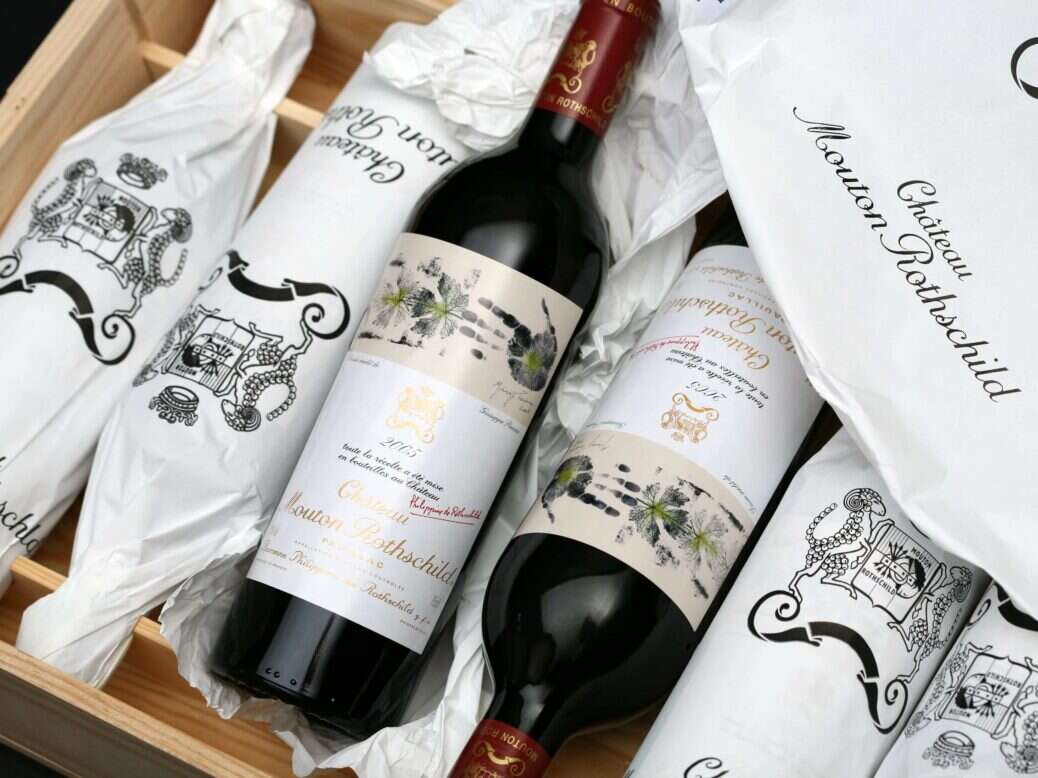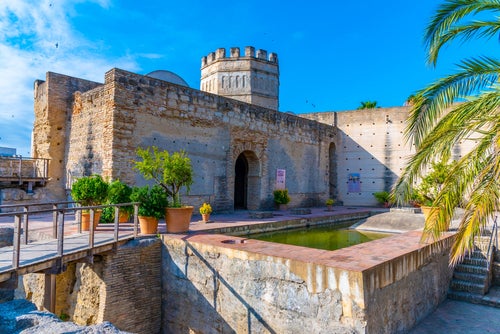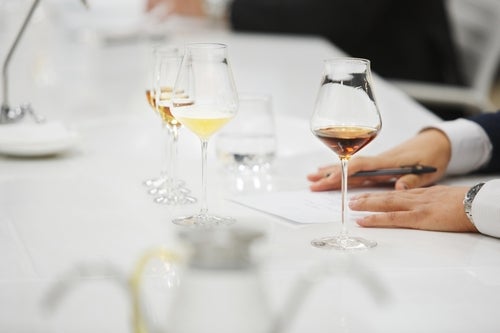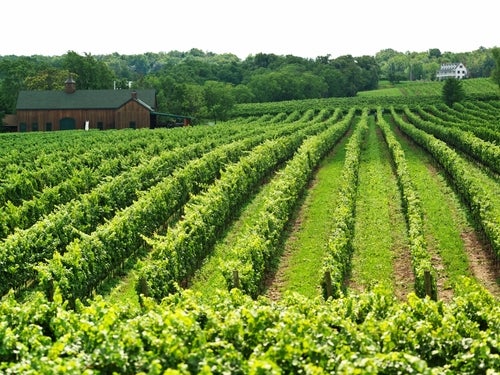
Each vintage, bottles of Château Mouton Rothschild feature the work of a world-leading artist. Sarah Kemp tells the stories behind the labels.
It must have been quite a moment when the glamorous Baroness Philippine de Rothschild stepped off a small boat in the middle of a steamy Mexican jungle, there to meet the legendary film director John Huston, who was on location filming Under the Volcano with Albert Finney. Tequila, backgammon, and negotiation ensued, and the result was a painting by Huston that embellished the superb 1982 vintage of Mouton Rothschild. Evidently—and unsurprisingly—there is, at Mouton, as much endeavour and effort in securing an artist as there is in producing one of the world’s greatest wines.
Many extraordinary episodes
As extraordinary as that episode is, it’s just one of many in the saga of the Mouton Rothschild wine labels, which had its beginnings nearly a century ago. Ironically, it’s a venture that began quite inauspiciously, but today, the collection contains the greatest modern artists of our time: Dali, Picasso, Henry Moore, Cocteau, Warhol, Jeff Koons, Gerhard Richter, and many more.
Now there is another chapter: Catherine Pégard, the President of the Palace of Versailles, recently approached the Rothschild family to create a joint project to raise funds for the restoration of the Palace. Since 2008, Versailles has annually featured a guest artist in a personal exhibition. Pégard realized that five of those artists had contributed labels for Mouton, and had the idea of creating a special case featuring the five bottles, celebrating these past guest artists of Versailles: Giuseppe Penone, Bernar Venet, Anish Kapoor, Jeff Koons, and Lee Ufan. One hundred cases were created; 75 were sold by auction at Sotheby’s in New York, London, and Hong Kong, raising $US 2.7 million, two thirds going to Versailles and one third diverted to Notre Dame after the devastating fire there.
Along with the unique cases, with their gold image of the Palace of Versailles screen-printed on the inside of the case, came an invitation to visit the château and a ticket to a gala dinner at Versailles where the legendary 1945 vintage was served. It is hard to think of a more extraordinary combination of national symbolism: Versailles, Mouton, power and beauty, history; France on steroids, in other words.
Certainly, this is all a long way from how it began.
Better dressed Mouton

The original idea of asking an artist to draw a label, in fact, had little to do with great artists. The label series started with Baron Philippe de Rothschild, who in 1922, at the age of 20, asked his father, Henri de Rothschild, to let him run the Mouton Rothschild estate. Henri had no interest in the estate at all—nor, amazingly, in wine. He was a remarkable man, a doctor, inventor, racing driver, playwright, and creator of Le Théatre Pigalle. His taste in art was for 17th- and 18th-century paintings and medieval tapestries.
Philippe had been sent to Bordeaux as a boy in 1914, when the German army was threatening Paris, and later spent his summer holidays close to the splendid beaches of d’Arcachon. Mouton was only a few hours away, and he fell in love with it, discovering the joys of onions, garlic, cabbage soup, and the freeform bonhomie there.
In the 1920s, Bordeaux was not at all glamourous, and a wretched, uncomfortable journey from Paris, taking the best part of 24 hours. There was no grand château at Mouton, only somewhat rundown farmhouses with no electricity or running water among the vineyards, including a large house the size of a vicarage, built in 1885, which is paradoxically called Petit Mouton, which is now used only by the family and to host their closest friends.
Philippe takes over
Philippe was only 20 years old when he took over in 1922, after persuading his father to let him run the estate. What Bordeaux made of the energetic, debonair young Rothschild can only be guessed at. This was no young man retiring to the country; he was already known as a keen yachtsman, racing driver, soon to be film-maker (he produced France’s first talking picture, Lac aux Dames) and producer of plays at his father’s theater in Paris. He was also, however, fascinated by the process of making and selling fine wine, and was convinced the process could be improved.
In 1924 he introduced estate bottling to control quality, a revolutionary idea at the time, now of course commonplace. Until that time the wine had been sent off to the négociants and retailers to bottle the wine (Berry Brothers were not amused by his decision). To celebrate the new estate bottling, and to draw attention, he decided to commission a highly individual label.
The latest thing

In Joan Littlewood’s biography, Milady Vine, he wrote, “I was sick and tired of seeing Mouton go out into the world badly dressed, sporting that dreary 19th century label with no design at all, and no color… What would be right? It would have to be something special, my first label. Why not the latest thing, a Cubist design? Jean Carlu was famous for introducing Cubism into advertising, you could see his work on all the hoardings of Paris. Just the man. When he sent me his design, I was thrilled with it.”
Baron Philippe may have been thrilled, but the market was horrified. His grandson Julien de Beaumarchais de Rothschild, who today oversees the labels, explained, “The reaction was not good, people said what is that on the wine, we don’t do that, it has to stop!” The striking label, with its combination of five arrows, ram’s head in black and gray with a pale brown chais in a Cubistic style, with the words “Ce vin a été mis en bouteille au château,” was swiftly dropped, though as Julien added wryly, “it must have pleased some négociants, as my mother found some other old vintages with the Carlu label on.” (And in the end, Baron Phillippe forever had the last word: The Carlu design, postage-stamp-sized and now in gold, is featured on every label as a kind of hallmark, just above the château’s name.)
It wasn’t until 1945 when he returned from war that Baron Philippe decided to create a new label to celebrate the return of peace. The legendary 1945 label has a V for victory, honoring Churchill. The young artist, Phillipe Jullian, wasn’t well known. “My grandfather wouldn’t have dared ask the great artists in the 1920s,” Julien explained, “only people he knew and had an easy link to. It was about friendship, people who were close to the family, whom he liked. Respect for the wine was not the same before the 1980s, so it was quite amusing to have a little drawing,” he continued, “and of course Mouton pre-1973 wasn’t a first growth.” Luckily, the Baron, who was embedded in the heart of France’s theatrical and literary world, counted Jean Cocteau, Jean Hugo, and Carzou among his friends.
The “little drawings” changed when one day Baron Philippe received an unexpected phone call from Georges Braque. “I don’t think my grandfather ever got over the shock!” Braque had heard that there was a different artist each year and was intrigued. It also helped that he was a wine lover.
Braque opens the door
Braque was the first internationally renowned painter to illustrate the label, for the 1955, a delightful ink and watercolor of a glass with grapes to the side. That label opened doors, as other artists took note. “My grandfather thought if Mouton couldn’t be a first growth, it had to be different,” said Julien. “What was brilliant was that he separated the technical part of the label from the artists’ space, he had a sense of what was permanent for Mouton and what was impermanent, the changing of the artist. Very pensé.”
(The only time the label was taken over completely by an artist was when Bob Wilson, the Texan theater and opera director, designed the 2001 label with a drawing of Philippine in a symphony of colors. Wilson was a close friend of Philippine’s and Julien’s father, Jean-Pierre de Beaumarchais who later told me, “It was one of the rare occasions when I had a disagreement with my wife.” His concern, that other artists would want to follow suit, didn’t materialize, however. De Beaumarchais added, “It is very positive that the painters have their own space, they are illustrators, not poster designers.”)
Braque’s intervention changed the series of labels, from friends of Philippe’s, to famous artists who wanted to be seen on the Mouton label. “My grandfather was straightforward,” Julien explained, and sometimes that straightforwardness led to famous artists having their noses put out of joint. Philippine later spent a lot of time wooing artists his grandfather had upset. Baron Philippe rejected Tàpies’ first label, which contained a red cross, as he thought it could be mistaken for medicine in a bottle. It was down to Philippine’s legendary powers of persuasion that he agreed to the 1995 label.
Fame didn’t play a part either, nor diplomacy. Baron Phillippe asked Dorothea Tanning, instead of her husband Max Ernst, because he preferred her drawings, for example. Another early invitee was David Hockney. He was whisked off by the theater director Joan Littlewood, a close friend of Baron Philippe’s, to a bar in Pauillac to taste a vin ordinaire so he would know the difference at dinner when Château Mouton Rothschild was served. Whether that helped with the conversation, we will never know, but the drawing he produced was not accepted and it wasn’t until decades later that he was finally persuaded to draw the 2014 label, after a useful call from Lord Jacob Rothschild.
Artistic temperaments and powers of persuasion
Baron Philippe’s second wife, Pauline, was fully involved in collecting the artefacts that today adorn the Mouton exhibition, but when it came to choosing the artist for the label, it was down to the Baron, until the 1980s, when Baron Philippe’s health was fading and his daughter Philippine became involved.
It was a baptism of fire, as Jean-Pierre de Beaumarchais explained: “Her first big step was the John Huston label. Philippe very much wanted a label by his friend John Huston, the legendary film director, who also was a huntsman, art collector, and talented painter from an early age. The old lady in charge of the labels didn’t know how to contact him, so Philippine decided to go and find him.”
She discovered he was shooting Under the Volcano, the adaptation of Malcolm Lowry’s novel about an alcoholic British consul, in a remote spot that could be reached only by boat, close to where Huston lived near Puerta Vallarta in Mexico.
Philippine set off alone, and arrived in a place described by her husband as “a place not known by men or gods.” After three days, she returned with a commitment for the label, a watercolor of a ram leaping in Dionysiac joy accompanied by the sun and a vine. It adorns the legendary 1982 vintage. It was one of the first labels in which she was actively involved, and today remains one of the most popular.
Charm and determination

Whereas Baron Philippe had started out by asking friends, Philippine considered that Mouton was “a very glorious wine” and sought out painters who would reflect Mouton’s new first-growth status. There weren’t many who could resist her charm or determination.
Francis Bacon was one who tried. Originally, he refused to see her, so she opted for confrontation. As Julien recounts, “She had been warned that it would be a total failure, that he would be a wreck, they said you are mad.” Dismissing all warnings about his heavy drinking, she plowed ahead, booked herself into the Capital hotel and then turned up on his doorstep, unannounced. She banged on the door and eventually he opened it and let her in. Bacon had been confined to bed by the doctor. She found him sober; apparently, he was drunk only at weekends. Asked what he was planning to do that day he replied, “Buy socks,” and so the Baroness and Bacon headed to Harrods on a sock-buying exhibition. A couple of days later he appeared at the Capital with his drawing, in a Harrods bag.
Unfortunately, he died shortly afterwards. The drawing was one of his last works, and though he had signed the drawing, he hadn’t signed the rights for reproducing them for the label. Jean-Pierre takes up the story: “The Marlborough gallery, who represented him, refused to believe that he had painted it, as he was ill in bed and not allowed out.” After two hours with the formidable Philippine, the director of the gallery was convinced, and the rights were granted.
Balthus was one of the few times when Philippine’s charm failed. Julien recounts, “Mummy would make people melt but with Balthus her methods failed.” It was her husband Jean-Pierre who disarmed the painter by mentioning that his uncle had lived in the same building in the 8ème district of Paris as Balthus’s parents, and a mention of a certain young woman whom they all admired created a sense of nostalgia that paved the way to more positive discussions.
Art in the broadest sense

The choice of artists has always remained with the family, and there is a delightful lack of planning in it. No direction is given, just the dimensions. “We ask them to respect the size,” Philippe Sereys de Rothschild says, “and of course they don’t,” he laughs. Nor is there a house style, so there is a range, from Keith Haring’s dancing rams in an almost aboriginal style, to Henry Moore’s spiritual golden chalices. Julien sends catalogues, past drawings, visits the artist, whenever possible hosts them at Mouton, and awaits the result. The family have always liked the artists to visit Mouton. “We see them as humans before artists,” Julien told me.
The artists are paid in wine from two different years, including the one for which they have provided the artwork; the family seem delighted when the artists refer to it as “my vintage.”
The name of the next artist is a well-kept family secret. Philippe Dhalluin, the technical director, tells me that even he is surprised. (Serendipity also plays a part. Philippe Sereys de Rothschild was in California visiting Opus One, the joint venture between Mouton and Robert Mondavi, and happened to see William Kentridge’s settings for The Magic Flute in San Francisco’s Museum of Modern Art. The choice was easy, and Kentridge’s “Bacchic characters” adorns the 2016 vintage.)
Curating Mouton

Curating the Versailles exhibition was straightforward. As the wines were chosen due to the artists, the vintages were settled. Luckily there were three stellar vintages, the 2005 (illustrated by Giuseppe Penone), 2009 (Anish Kapoor), and 2010 (Jeff Koons), along with two more challenging ones, 2007 (Bernar Venet) and 2013 (Lee Ufan).
A replica of the elegantly simple presentation case (the wood is a replica of Versailles’s floor), now sits in the middle of the exhibition of labels which has, after touring the world, found a permanent home at Mouton in the Paintings for Labels room, which lies between the Barrel Hall and Vat Room. The original idea of the exhibition was Philippine’s, and in 1981 she decided that rather than file away the artworks, there should be a traveling exhibition, so the labels were seen across the world, from the V&A in London, to the Hermitage in St Petersburg, the China National Art Gallery, and many more.
Each of the labels is framed in a glass cabinet, with information about the artist, artefacts and photos and sometimes the correspondence between the family and the artist. (There is a delightful note from Keith Haring asking Philippine if they would make up their mind about his drawing—it was a transition time between Baron Philippe and Baroness Philippine, and Haring had written to Baron Philippe but not received an answer.)
It is well worth putting aside an afternoon to visit. While I was there, I was taken to an atelier where Véronique Debord, who is in charge of preparing the display cases, was meticulously pinning the torn black tissue that comprised William Kentridge’s 2016 The Triumphs of Bacchus into the box, where it was to join the rest of the collection.
Close collaboration
Today Mouton Rothchild is run by Philippe Sereys de Rothschild, Camille Sereys de Rothschild, and Julien de Beaumarchais de Rothschild, the three children of Baroness Philippine. Though Julien is in charge of the artistic side of the business, and is well qualified to do so having studied art history and prior to Mouton worked with leading art expert Artemis Fine Arts and Salamander Fine Arts, it is clear from their affectionate banter that they enjoy the joint discussions and collaborate closely on the choice of artist.
Despite the tradition, there are actually a few vintages that don’t have an artist; the Millennium vintage is striking, with the gold engraving of “the Ausburg ram” one of the treasures in the Museum of Wine in Art. “It took many months, as the gold wouldn’t stick,” Julien confided. The 1977 vintage is dedicated to the Queen Mother, who spent three days at Mouton during her official visit to Bordeaux in April 1977. (In China it is the vintage where the label has boosted the price out of kilter with the vintage.) The 1953 and 2003 commemorate the château’s centenary and 150th anniversary respectively.
There is no question that art and the Rothschilds at Mouton are inseparable—it is in their DNA, from Henri, playwright, Philippe, film maker and producer, and Philippine, actress at La Comédie-Française. Though the family Foundation also supports ballet and music, the labels are their best-known contribution. Philippe explains, “It’s art in the broadest sense of art, not exclusively gallery art.” Could there be a new medium on the labels? Julien adds, “I’d love to use new media, perhaps video.” Knowing the family’s openness to the new and the bold, I have no doubt that, whether it takes trips through jungles, or inspiration from Versailles, we may see it on a Mouton label—after all, it is part of Mouton’s heritage to change the status quo.






